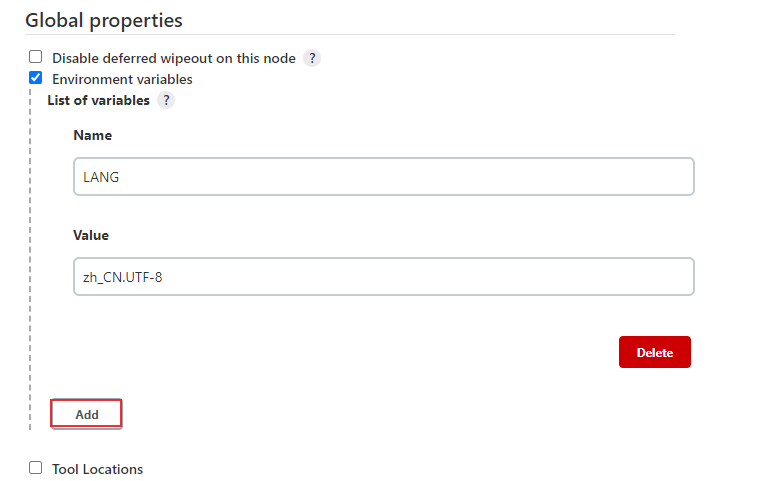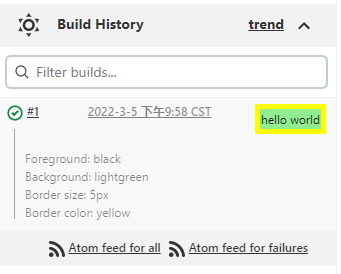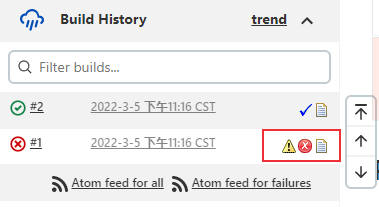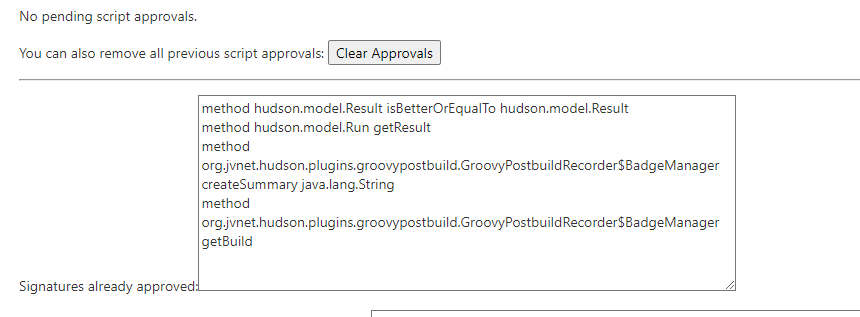持续集成:Jenkins pipeline全局变量
在编写Jenkins Pipeline脚本时,需要使用到一些全局变量,比如环境变量jenkins URL、项目地址,保存在env变量中(字符串类型),可以在Jenkins Pipeline或者其它Jenkinsfile中使用这些变量。本文介绍jenkins 中env、params、currentBuild和manager这几种全局变量。
Jenkins 全局变量
Jenkins平台支持的全局变量可通过地址${JENKINS_URL}/pipeline-syntax/globals 访问。主要包括以下全局变量:
env:在groovy代码和 Jenkins pipeline中以env.VARNAME或直接以VARNAME的形式访问环境变量。params:将构建中定义的所有参数公开为具有不同类型值的只读映射,通过params来访问。currentBuild:顾名思义,它处理Jenkins管道当前正在运行的构建。manager:Groovy Postbuild插件提供的全局变量。docker:这是为了在一个Groovy脚本的Jenkins管道中提供方便的访问docker相关函数。
下面来举例说明如何使用。
下面的示例中,groovy脚本在Pipeline 共享库中编写,pipeline脚本直接在pipeline工程的pipeline输入框中编写。pipeline共享库的定义可以参考 持续集成:Jenkins Pipeline共享库定义和使用 。
env
查看环境变量
可通过多种方式查看jenkins可使用的环境变量:
- 访问:${JENKINS_URL}/pipeline-syntax/globals
- 访问:${JENKINS_URL}/env-vars.html/
- 使用windows bat命令:
set - 使用Linux/Unix shell命令:
printenv
bat和shell命令可以在pipeline中编写:
pipeline{
agent {
label "master"
}
stages{
stage('Parallel Stage') {
parallel {
stage('windows') {
agent {
label "win_agent"
}
steps {
bat 'set'
}
}
stage('linux') {
agent {
label "linux_agent"
}
steps {
sh 'printenv'
}
}
}
}
}
}
由于打印内容较多,这里就不展示结果了。这两个命令除了返回jenkins平台的环境变量外,还会打印对应代理节点的环境变量。
使用环境变量
可以以 env.VARNAME 或直接以 VARNAME 的形式访问环境变量。
pipeline脚本:
// @Library('pipelinelibs2@main') // Github库
@Library('pipelinelibs@1.0') _ // SVN库
import com.hiyongz.MyLib
def mylib = new MyLib();
mylib.getJenkinsHome();
println "${JENKINS_HOME}";
println "${env.JENKINS_HOME}";
MyLib.groovy:
def getJenkinsHome(){
println "${JENKINS_HOME}";
println "${env.JENKINS_HOME}";
}
构建结果日志:
[Pipeline] echo
/var/jenkins_home
[Pipeline] echo
/var/jenkins_home
[Pipeline] echo
/var/jenkins_home
[Pipeline] echo
/var/jenkins_home
[Pipeline] End of Pipeline
Finished: SUCCESS
创建环境变量
除了读取环境变量外,也可以对环境变量进行赋值或者创建新的环境变量。声明环境变量可以使用以下3种方式:
withEnv(["VARIABLE_NAME=value"]) {}, 脚本式流水线语法,可以覆盖任何环境变量。env.VARIABLE_NAME:只能覆盖以env.VARIABLE_NAME的方式创建的环境变量。environment { },声明式流水线语法,不能以env.VARIABLE_NAME的方式覆盖。
pipeline脚本:
// @Library('pipelinelibs2@main') // Github库
@Library('pipelinelibs@1.0') _ // SVN库
import com.hiyongz.MyLib
def mylib = new MyLib();
env.MY_VERSION = '1.0'
mylib.myEnv();
println "MY_VERSION = ${MY_VERSION}";
println "MY_VERSION = ${env.MY_VERSION}";
pipeline{
agent {
label "master"
}
environment {
ENV1 = "env1"
}
stages{
stage("Env Test") {
environment {
ENV1 = "env1_1" // 覆盖environment{}块创建的环境变量
BUILD_NUMBER = "666" // 可以覆盖以`env.VARIABLE_NAME`方式赋值的环境变量。
}
steps {
println "ENV1 = ${env.ENV1}";
println "BUILD_NUMBER = ${env.BUILD_NUMBER}";
script {
env.MY_VERSION = "2.0" // env.MY_VERSION会被覆盖
env.ENV1 = "env1_2" // env.ENV1不会被覆盖
}
println "ENV1 = ${env.ENV1}";
println "MY_VERSION = ${env.MY_VERSION}";
withEnv(["ENV1=env1_3"]) { // env.ENV1会被覆盖
echo "ENV1 = ${env.ENV1}"
}
}
}
}
}
MyLib.groovy:
def myEnv(){
println "MY_VERSION = ${env.MY_VERSION}";
println "MY_VERSION = ${MY_VERSION}";
}
构建结果日志:
MY_VERSION = 1.0
MY_VERSION = 1.0
MY_VERSION = 1.0
MY_VERSION = 1.0
ENV1 = env1_1
BUILD_NUMBER = 666
ENV1 = env1_1
MY_VERSION = 2.0
ENV1 = env1_3
新创建的环境变量在groovy也可以通过如下方式获取:
def myEnv(){
def jobVariables = currentBuild.getBuildVariables();
println "${jobVariables.MY_VERSION}";
}
在pipeline script中创建的环境变量只能在当前pipeline工程中生效,如果想要设置全局环境变量,可以在jenkins系统配置中进行配置。
进入【Manage Jenkins】-> 【Configure System】-> 【Global properties】,新增环境变量,这里设置的环境变量是全局生效的。

params
对于参数的读取可以使用params来访问,groovy脚本中可以使用params.get()和env.getProperty()方法来获取:
def ParamDemo(){
def deploy_env = params.get("DEPLOY_ENV") // or: params."${paramName}"
println "DEPLOY_ENV = ${deploy_env}";
def debug_build = env.getProperty("DEBUG_BUILD")
println "DEBUG_BUILD = ${debug_build}";
}
pipeline脚本如下:
// @Library('pipelinelibs2@main') // Github库
@Library('pipelinelibs@1.0') _ // SVN库
import com.hiyongz.MyLib
def mylib = new MyLib();
pipeline{
agent {
label "master"
}
parameters {
string(name: 'DEPLOY_ENV', defaultValue: 'staging', description: '')
text(name: 'DEPLOY_TEXT', defaultValue: 'One\nTwo\nThree\n', description: '')
booleanParam(name: 'DEBUG_BUILD', defaultValue: true, description: '')
choice(name: 'CHOICES', choices: ['one', 'two', 'three'], description: '')
password(name: 'PASSWORD', defaultValue: 'SECRET', description: 'A secret password')
}
stages{
stage("Param Test") {
steps {
script {
println "DEPLOY_ENV = ${params.DEPLOY_ENV}";
mylib.ParamDemo();
}
}
}
}
}
构建结果:
DEPLOY_ENV = staging
[Pipeline] echo
DEPLOY_ENV = staging
[Pipeline] echo
DEBUG_BUILD = true
currentBuild
currentBuild变量可以用来获取当前构建的一些属性,比如absoluteUrl、projectName、result等,更多支持的属性方法可以访问:${JENKINS_URL}/pipeline-syntax/globals 。
pipeline{
agent {
label "master"
}
stages{
stage("Param Test") {
steps {
script {
println "build number: ${currentBuild.number}";
println "current result: ${currentBuild.currentResult}";
println "build URL: ${currentBuild.absoluteUrl}";
}
}
}
}
}
manager
manager是Groovy Postbuild插件提供的全局变量,用于构建后操作,它是在jenkins JVM 中执行groovy脚本。可用来更改构建结果,显示构建摘要信息等,下面来举几个例子。
1、addShortText方法
语法:addShortText(text, color, background, border, borderColor)
pipeline {
agent {
label 'master'
}
stages {
stage('manager usage') {
steps {
script {
manager.addShortText("hello world",'black','lightgreen','5px','yellow')
currentBuild.description = "Foreground: black\n"
currentBuild.description += "Background: lightgreen\n"
currentBuild.description += "Border size: 5px\n"
currentBuild.description += "Border color: yellow"
}
}
}
}
}
效果如下图:

2、添加徽章图标
添加删除图标相关方法:
- addBadge(icon, text)
- addBadge(icon, text, link)
- addWarningBadge(text)
- addErrorBadge(text)
- addHtmlBadge(html)
- removeBadges()
- removeBadge(index)
还可以设置构建结果:
- buildUnstable() - 设置构建结果为 UNSTABLE.
- buildFailure() -设置构建结果为 FAILURE.
- buildSuccess() - 设置构建结果为 SUCCESS.
pipeline脚本举例:
pipeline {
agent {
label 'master'
}
stages {
stage('manager usage') {
steps {
script {
echo "buildFailure test"
}
}
}
}
post {
always {
script {
if(manager.logContains(".*buildFailure.*")) {
manager.addWarningBadge("build Failure.")
manager.buildFailure()
}
if(manager.build.result.isBetterOrEqualTo(hudson.model.Result.UNSTABLE)) {
manager.addBadge("success.gif", "success")
} else {
manager.addBadge("error.gif", "failed")
}
manager.addBadge("text.gif", "console output","${currentBuild.absoluteUrl}/console")
}
}
}
}
构建效果图:

注意Groovy Postbuild 在2.0版本以后引入了 Script Security Plugi,对一些非白名单方法(比如上述脚本使用到的logContains、build方法)需要管理员同意,可以进入【Manage Jenkins】 > 【In-process Script Approval】同意相关方法:

参考资料:
欲忘忘未得,欲去去无由。——唐·白居易 《寄远》




 浙公网安备 33010602011771号
浙公网安备 33010602011771号